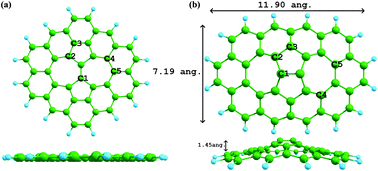当前位置:
X-MOL 学术
›
Phys. Chem. Chem. Phys.
›
论文详情
Our official English website, www.x-mol.net, welcomes your
feedback! (Note: you will need to create a separate account there.)
Gas adsorption efficacy of graphene sheets functionalised with carboxyl, hydroxyl and epoxy groups in conjunction with Stone–Thrower–Wales (STW) and inverse Stone–Thrower–Wales (ISTW) defects
Physical Chemistry Chemical Physics ( IF 2.9 ) Pub Date : 2017-11-01 00:00:00 , DOI: 10.1039/c7cp06900f Murugan Lalitha 1, 2, 3, 4 , Senthilkumar Lakshmipathi 1, 2, 3, 4
Physical Chemistry Chemical Physics ( IF 2.9 ) Pub Date : 2017-11-01 00:00:00 , DOI: 10.1039/c7cp06900f Murugan Lalitha 1, 2, 3, 4 , Senthilkumar Lakshmipathi 1, 2, 3, 4
Affiliation

|
The complete reduction of graphene oxide is difficult to achieve, and hence oxygen-containing functional groups do exist in graphene, along with structural defects. On the other hand, efficient gas sensor materials have been a subject of relentless interest. This instigates the need to explore the gas adsorption on STW and ISTW defective graphene sheets functionalised by –COOH, –OH and C–O–C groups, using density functional theory calculations. Both defects are experimentally feasible as evident through their formation energies. Furthermore mono-functionalisation induces significant buckling of the sheet; in contrast, bi-functionalisation of the sheet restores the planarity of the sheet. We found that the ISTW defective sheet is more reactive than the STW defective sheet to all the functional groups considered, and in particular –COOH is the most adsorptive group to both the defects, while epoxy has consistent adsorptivity towards the defects. Gas molecules such as CO2, H2, N2, CH4 and O2 are physisorbed, whereas HF and H2O are chemisorbed on the functionalised sheets. The sensitivity of the gas molecules towards the functionalised sheets is obtained by ΔEg, which is pronounced for pristine + OH and STW + epoxy and bare ISTW defective sheets. However, the functionalised sheets exhibit improved sensing properties for O2; specifically, mono-epoxy functionalised and bi-carboxylated defective sheets show high sensitivity towards O2. Furthermore, the surface functionalisation enhances the selectivity of the sensor. From the TDOS plot, the functionalised sheet exhibits p-type behaviour. Thus, the results of this study reveal that the functionalised defective sheets can be utilized as O2 sensors.
中文翻译:

具有羧基,羟基和环氧基官能团的石墨烯片材的气体吸附功效,并结合了斯通-威尔-威尔士(STW)和反斯通-威尔-威尔士(ISTW)缺陷
很难实现氧化石墨烯的完全还原,因此在石墨烯中确实存在含氧官能团以及结构缺陷。另一方面,有效的气体传感器材料一直是人们关注的主题。这就需要使用密度泛函理论计算来探索在由–COOH,–OH和C–OC–C基团官能化的STW和ISTW缺陷石墨烯片上的气体吸附。两种缺陷在实验上都是可行的,通过其形成能可以明显看出。此外,单功能化会导致板材明显弯曲。相反,片材的双功能化恢复了片材的平面性。我们发现ISTW缺陷表比STW缺陷表对所考虑的所有官能团的反应性更高,特别是–COOH是对这两种缺陷的最强吸附性基团,而环氧树脂对这些缺陷具有一致的吸附性。气体分子,如一氧化碳在图2中,H 2,N 2,CH 4和O 2被物理吸附,而HF和H 2 O被化学吸附在功能化片上。气体分子对功能化板材的敏感性通过ΔE g获得,对于原始+ OH和STW +环氧以及ISTW裸露板材而言,这是很明显的。然而,功能化片材表现出对O 2的改善的感测性能;具体而言,单环氧官能化和双羧基化的缺陷片材显示出对O 2的高敏感性。此外,表面功能化增强了传感器的选择性。从TDOS图可知,功能化板材表现出p型行为。因此,这项研究的结果表明,功能化的缺陷片材可以用作O 2传感器。
更新日期:2017-11-22
中文翻译:

具有羧基,羟基和环氧基官能团的石墨烯片材的气体吸附功效,并结合了斯通-威尔-威尔士(STW)和反斯通-威尔-威尔士(ISTW)缺陷
很难实现氧化石墨烯的完全还原,因此在石墨烯中确实存在含氧官能团以及结构缺陷。另一方面,有效的气体传感器材料一直是人们关注的主题。这就需要使用密度泛函理论计算来探索在由–COOH,–OH和C–OC–C基团官能化的STW和ISTW缺陷石墨烯片上的气体吸附。两种缺陷在实验上都是可行的,通过其形成能可以明显看出。此外,单功能化会导致板材明显弯曲。相反,片材的双功能化恢复了片材的平面性。我们发现ISTW缺陷表比STW缺陷表对所考虑的所有官能团的反应性更高,特别是–COOH是对这两种缺陷的最强吸附性基团,而环氧树脂对这些缺陷具有一致的吸附性。气体分子,如一氧化碳在图2中,H 2,N 2,CH 4和O 2被物理吸附,而HF和H 2 O被化学吸附在功能化片上。气体分子对功能化板材的敏感性通过ΔE g获得,对于原始+ OH和STW +环氧以及ISTW裸露板材而言,这是很明显的。然而,功能化片材表现出对O 2的改善的感测性能;具体而言,单环氧官能化和双羧基化的缺陷片材显示出对O 2的高敏感性。此外,表面功能化增强了传感器的选择性。从TDOS图可知,功能化板材表现出p型行为。因此,这项研究的结果表明,功能化的缺陷片材可以用作O 2传感器。











































 京公网安备 11010802027423号
京公网安备 11010802027423号